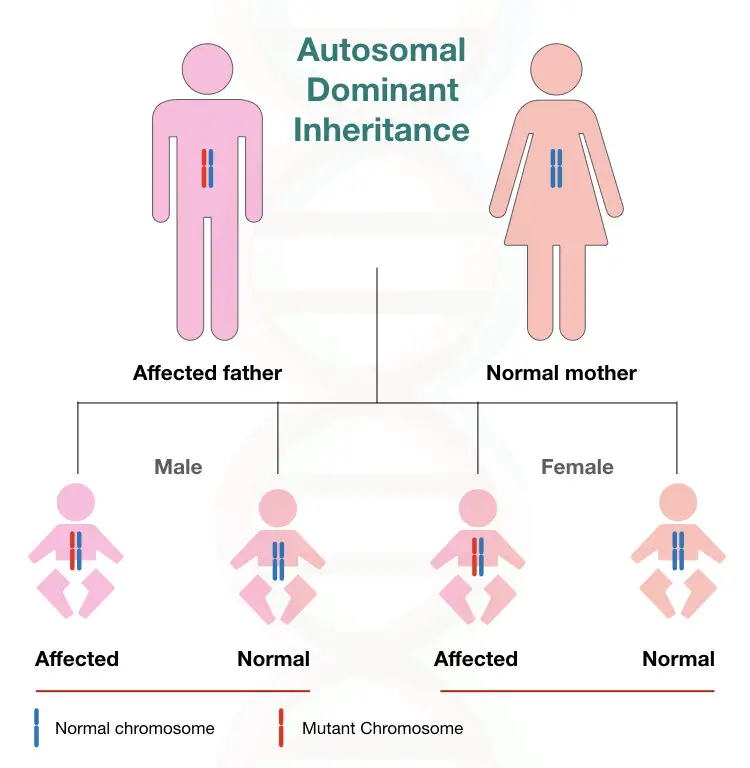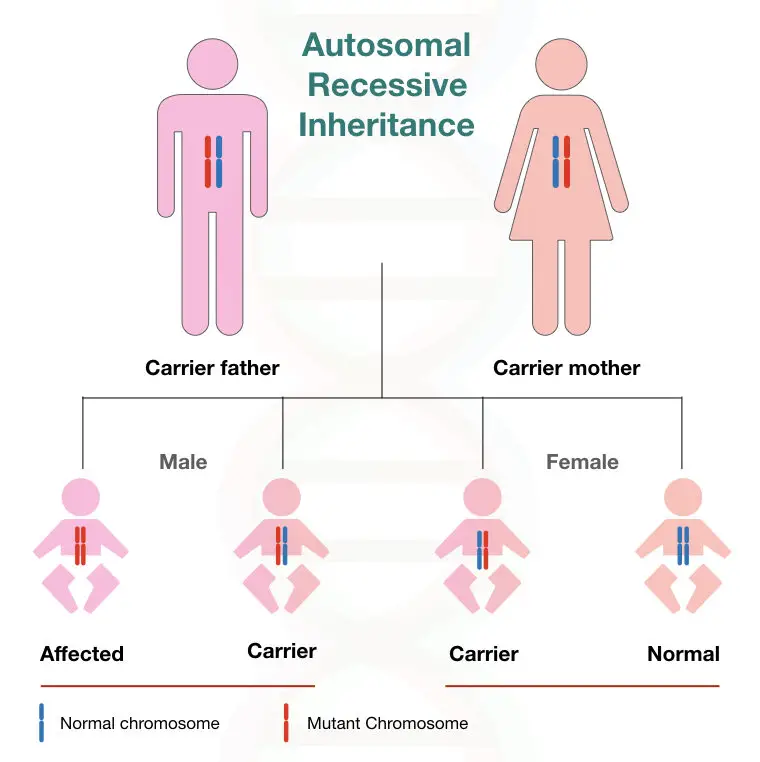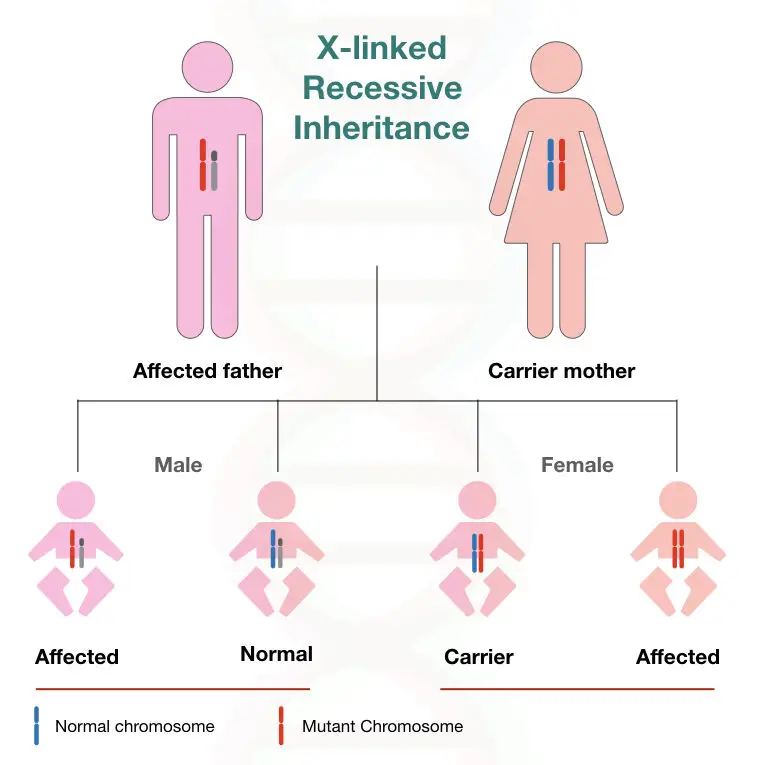“Inheritance or passing of a genetic trait or disease gene from one generation to another is referred to as genetic inheritance.”
Depending upon the cell types, the genetic inheritance can be divided into- Autosomal dominant and autosomal recessive or X-linked dominant and X-linked recessive.
Among 23 pairs of human chromosomes, 22 pairs are autosomal chromosomes with a single pair of sex chromosomes.
The DNA or genes are located on chromosomes. Genes on the autosomal chromosome are known as autosomal genes. Genes located on X or Y chromosomes are known as sex- chromosome genes.
“An alternative form of the gene is called an allele”.
The allele or gene expressed in offspring is a dominant one, contrary, the alleles which are not expressed, are recessive.
As the genes/alleles are inherited into offspring so the mutations on it, too pass on. therefore, the genetic condition either disorder or disease associated with a specific mutation also inherited.
In the present article, we will explain to you different types of inheritance patterns or genetic inheritance. Also, we will explain to you how different disorders or diseases are inherited into the offspring.
Lets start’s with the topics,
Key Topics:
Autosomal inheritance:
As we said earlier, genes located on autosomes are called autosomal genes.
In autosomal inheritance, the inheritance of genetic traits/ disease genes is governed by the alleles located on autosomes. It is further categorized into autosomal dominant and autosomal recessive inheritance.
Autosomal dominant inheritance:
In autosomal dominant inheritance, a single dominant allele is responsible for the occurrence of a phenotype. For an autosomal dominant disorder, we can state it as,
A single dominant mutant allele is sufficient for the occurrence of the disease is known as an autosomal dominant disorder.
This means a single defective gene from one of the parents is sufficient to cause disease.
For example, Huntington’s disease, Marfan syndrome, Neurofibromatosis type 1 and Achondroplasia.

Take a look at the example,
Here, a father has a faulty gene on one of the autosomes. However, the mother is normal. As you can see in figure 1, there is a 50% chance that two out of four children affected by the disease.
Also, 50% of offspring remains normal.
Autosomal dominant disorders:
Huntington’s disease, Marfan syndrome, Neurofibromatosis type 1, Achondroplasia and Myotonic muscular dystrophy are inherited in an autosomal dominant fashion.
Huntington’s disease
A single dominant HTT gene is responsible for Huntington’s disease. It’s present on chromosome 4 (autosome).
Cognitive and neurodegenerative problems are commonly seen in the present genetic condition. Walking, thinking and swallowing problems are usually observed in a person with Huntington’s disease.
It is a triplet repeat expansion disorder that occurs due to abnormal expansion of CAG trinucleotide.
Increased size of CAG triplet repeat number of HTT gene causes Huntington’s disease hence it is often called as triple repeat expansion disorder.
The normal range of CAG triplet repeats on the HTT gene is 27 to 35. Although the disorder is autosomal dominant there are three different conditions noted.
- <26 triplet repeats of CAG- normal
- 27 to 35 triplet repeats of CAG – intermedia
- 36 to 39 triplet repeats of CAG – penetrance
- Above 40 triplet repeats of CAG- affected
Huntington’s disease follows the inheritance pattern as shown in figure 1.
Now let’s understand the recessive one. Read our amazing article on how the present condition inherited: How Is Huntington’s Disease Inherited?
Autosomal recessive inheritance:
“Two homozygous recessive alleles are responsible for the occurrence of the phenotype.” For an autosomal recessive disorder, the present condition is defined as,
Inheritance of two copies of the mutant gene is required in order to cause disease in offspring.
Here is an interesting catch,
With a single recessive allele, an individual remains normal. Although, it is categorized as a carrier of the disease due to its heterozygous genotype.

See figure 2,
Only 25% of babies may get affected.
Contrary, 50% of the offspring are a carrier and don’t have disease symptoms with a 25% chance of normal child.
If only a single parent is a carrier, none of the offspring suffers from the disease. Still, there is a 50% chance of a carrier.
Autosomal recessive disorders:
Cystic fibrosis, Sickle cell anemia and Tay-Sachs disease are three classical examples of autosomal recessive disorders.
Let us understand the mechanism of autosomal recessive inheritance by an example,
Sickle cell anaemia:
Atypical hemoglobin chain (called hemoglobin S) causes red blood cells to become sickle-shaped.
decrease RBCs, anemia, pain crisis and infections are common problems associated with the present condition.
The threat of stoke and severe bacterial infection remains throughout life.
It affects an estimated 1 out of 500 children worldwide.
The normal HBB gene is responsible for the production of normal hemoglobin. However, the HbS is the mutant allele of the HBB gene, causes sickle cell anemia.
In the homozygous recessive condition, two mutant copies of the HBB gene (HbS) cause sickle cell anemia.
The carrier with a single Hbs allele appears normal without any complications.
Another common autosomal recessive inherited disorder is Cystic fibrosis.
Cystic fibrosis:
Cystic fibrosis is a single gene disorder, caused by the CFTR gene mutation.
A type of recessive autosomal disorder, the cystic fibrosis gene is located on chromosome number 7. Cystic fibrosis transmembrane conductance regulator gene encodes cell membrane channel protein. This protein helps in the secretion of mucus, tear and saliva.
Furthermore, it regulates the transportation of chloride ions across the membrane. Mutation in the CFTR gene results in the accumulation of thick mucus in the lung and the ion channel across the membrane is disturbed.
Thick sputum, wheezing and coughing are the most common symptoms of CF. Due to the low immunity, a patient may suffer from repeated lung infections.
Read our amazing article on the inheritance of the present condition: How Is Cystic Fibrosis Inherited?
Sex-linked inheritance:
A pair of sex chromosomes are present in humans, XX in a female and XY in a male.
Genes presents on the X chromosome are said to be X-linked and on Y said to be Y-linked. Both types of the gene have a different inheritance pattern.
Human sex is decided by the presence or absence of the Y chromosome. If a Y chromosome is present along with the X chromosome, the embryo develops into a male. If Y is absent the embryo will develop into a female.
The Sex-determining region on Y (SRY) is responsible for the development of the embryo into the male sex. However, genes on X chromosomes are homologous and genes on the Y chromosome are non-homologous.
Anyway coming to our original topics,
X-linked inheritance:
Genes present on the X chromosome are known as X-linked genes.
X-linked genes are inherited just like autosomes (either dominant or recessive). However, the phenotypic effect of X-linked inheritance is different in both males and females.
As males contain only single X chromosomes, the chance of inheritance of the disease is higher in males as compared to females. In the case of X-lined disorders, males are always remains affected in almost all cases.
Even if the condition is X-linked dominant or recessive, the male offspring persists in the disease because of the presence of a single X chromosome.
(How sad it is!) anyway, Let’s go further,
X linked dominant inheritance:
“A single dominant allele of the X chromosome is sufficient to pass on a trait.”
For a disease gene, a single dominant gene located on the X chromosome is enough to cause disease in both males and females.

From figure 3 you can understand how the present condition happens.
There is a 50% chance of disease in offspring with 50% of normal offspring.
X-linked dominant disorders:
Ratt syndrome and fragile X syndrome are comment types of X-linked dominant disorders. As we said earlier, in the present condition, males are more at risk of the occurrence of disease.
Fragile X syndrome:
A mutation in the FMR1 gene is responsible for the development of fragile X syndrome.
Developmental delay, cognitively impaired and learning disabilities are common symptoms of fragile X syndrome.
Additionally, individuals may suffer from a wide range of mental disorders like delayed speech development, delayed language and lower intelligence.
Fragile X is also a triple repeat expansion disorder in which abnormal CGG repeats result in the mutant phenotype. The normal range of CGG repeats in the FMR1 gene is 5-40 repeats.
The range of CGG repeats in humans are:
- 1-40 range of CGG repeats is a normal state
- 40- 200 pre-mutation
- More than 200 CGG repeats disease state
Pre-mutation is a condition in which the individual may carry the mutant FMR1 gene.
X linked recessive inheritance:
In X-linked recessive inheritance, the presence of two recessive alleles produces a mutant phenotype.
Hence in X-linked recessive disorders, only one out of 4 females become affected, all males of the progeny become affected.
However, two heterozygous females become a carrier. Carrier is a condition in which the individual remains normal but carries the mutant allele and this mutant allele can be inherited in subsequent generations.

X-linked recessive disorders:
Haemophilia and Duchenne muscular dystrophy are two common types of X-linked recessive disorders.
Hemophilia:
Haemophilia A and hemophilia B are X-linked bleeding disorders. People with hemophilia experience prolonged bleeding.
Even a minor cut results in heavy blood loss. The condition becomes even worse in case of internal bleeding in joints, brain and internal organs.
In females, the chance of disorder is fewer due to the presence of two X chromosomes. However, males with a mutant allele always remain affected.
Haemophilia is most frequent in males as compared to females. Haemophilia A is even the most common disorder and affects 1 in 5000 males as compared to hemophilia B (1 in 20,000 females) worldwide.
Y linked inherited disorder:
Y-linked disorders are very rare in nature as the Y chromosome is present only in males. However, some of the genes present on Y chromosomes are inherited from male to male.
The Y chromosome is the smallest chromosome and contains only a few genes. Most of the Y chromosomal genes are related to fertility and maleness. If the mutation occurs in Y chromosomal genes, like the SRY gene, the individual suffers from infertility.
It indicates that if a person is suffered from infertility, it cannot reproduce and cannot produce offspring. Hence Y Y-linked disorders are rarest among rare.
Extrachromosomal inheritance:
Genes present in mitochondria and chloroplast are inherited in a non-mendelian pattern. Extrachromosomal genes do not follow any distinct pattern of inheritance. Mutant gene inherited randomly.
For more detail on extrachromosomal inheritance please read the articles:
- Extrachromosomal inheritance class 1: Introduction to maternal inheritance
- Extrachromosomal inheritance class 2: organelle DNA

Conclusion:
Conclusively, we can say, nuclear genes are inherited in the mendelian pattern while some extrachromosomal genes don’t follow the exact pattern. Using the present knowledge in the diagnosis of disease, normal, carrier or diseased individuals can be distinguished using the DNA test.


